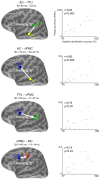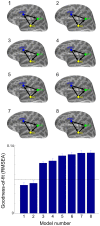Enhanced neural synchrony between left auditory and premotor cortex is associated with successful phonetic categorization
- PMID: 24834062
- PMCID: PMC4018533
- DOI: 10.3389/fpsyg.2014.00394
Enhanced neural synchrony between left auditory and premotor cortex is associated with successful phonetic categorization
Abstract
The cortical dorsal auditory stream has been proposed to mediate mapping between auditory and articulatory-motor representations in speech processing. Whether this sensorimotor integration contributes to speech perception remains an open question. Here, magnetoencephalography was used to examine connectivity between auditory and motor areas while subjects were performing a sensorimotor task involving speech sound identification and overt repetition. Functional connectivity was estimated with inter-areal phase synchrony of electromagnetic oscillations. Structural equation modeling was applied to determine the direction of information flow. Compared to passive listening, engagement in the sensorimotor task enhanced connectivity within 200 ms after sound onset bilaterally between the temporoparietal junction (TPJ) and ventral premotor cortex (vPMC), with the left-hemisphere connection showing directionality from vPMC to TPJ. Passive listening to noisy speech elicited stronger connectivity than clear speech between left auditory cortex (AC) and vPMC at ~100 ms, and between left TPJ and dorsal premotor cortex (dPMC) at ~200 ms. Information flow was estimated from AC to vPMC and from dPMC to TPJ. Connectivity strength among the left AC, vPMC, and TPJ correlated positively with the identification of speech sounds within 150 ms after sound onset, with information flowing from AC to TPJ, from AC to vPMC, and from vPMC to TPJ. Taken together, these findings suggest that sensorimotor integration mediates the categorization of incoming speech sounds through reciprocal auditory-to-motor and motor-to-auditory projections.
Keywords: MEG; dorsal stream; magnetoencephalography; premotor cortex; sensorimotor integration; speech perception.
Figures





Similar articles
-
Enhanced early-latency electromagnetic activity in the left premotor cortex is associated with successful phonetic categorization.Neuroimage. 2012 May 1;60(4):1937-46. doi: 10.1016/j.neuroimage.2012.02.011. Epub 2012 Feb 14. Neuroimage. 2012. PMID: 22361165
-
Automatic phoneme category selectivity in the dorsal auditory stream.J Neurosci. 2013 Mar 20;33(12):5208-15. doi: 10.1523/JNEUROSCI.1870-12.2013. J Neurosci. 2013. PMID: 23516286 Free PMC article.
-
Effective connectivity hierarchically links temporoparietal and frontal areas of the auditory dorsal stream with the motor cortex lip area during speech perception.Brain Lang. 2012 Sep;122(3):135-41. doi: 10.1016/j.bandl.2011.09.005. Epub 2011 Oct 24. Brain Lang. 2012. PMID: 22030113
-
Stimulus-dependent activations and attention-related modulations in the auditory cortex: a meta-analysis of fMRI studies.Hear Res. 2014 Jan;307:29-41. doi: 10.1016/j.heares.2013.08.001. Epub 2013 Aug 11. Hear Res. 2014. PMID: 23938208 Review.
-
Dorsal and ventral streams: a framework for understanding aspects of the functional anatomy of language.Cognition. 2004 May-Jun;92(1-2):67-99. doi: 10.1016/j.cognition.2003.10.011. Cognition. 2004. PMID: 15037127 Review.
Cited by
-
Studying Sub-Dendrograms of Resting-State Functional Networks with Voxel-Wise Hierarchical Clustering.Front Hum Neurosci. 2016 Mar 8;10:75. doi: 10.3389/fnhum.2016.00075. eCollection 2016. Front Hum Neurosci. 2016. PMID: 27014015 Free PMC article.
-
Contributions of local speech encoding and functional connectivity to audio-visual speech perception.Elife. 2017 Jun 7;6:e24763. doi: 10.7554/eLife.24763. Elife. 2017. PMID: 28590903 Free PMC article.
-
Don't speak too fast! Processing of fast rate speech in children with specific language impairment.PLoS One. 2018 Jan 26;13(1):e0191808. doi: 10.1371/journal.pone.0191808. eCollection 2018. PLoS One. 2018. PMID: 29373610 Free PMC article.
-
Auditory cortical deactivation during speech production and following speech perception: an EEG investigation of the temporal dynamics of the auditory alpha rhythm.Front Hum Neurosci. 2015 Oct 8;9:534. doi: 10.3389/fnhum.2015.00534. eCollection 2015. Front Hum Neurosci. 2015. PMID: 26500519 Free PMC article.
-
Interacting parallel pathways associate sounds with visual identity in auditory cortices.Neuroimage. 2016 Jan 1;124(Pt A):858-868. doi: 10.1016/j.neuroimage.2015.09.044. Epub 2015 Sep 28. Neuroimage. 2016. PMID: 26419388 Free PMC article.
References
LinkOut - more resources
Full Text Sources
Other Literature Sources

